History
Wikipedia describes augmented reality as an interactive experience of a real-world environment whereby the objects that reside in the real-world are “augmented” by computer-generated perceptual information. Although this definition is what we associate as augmented reality today, concepts of the term have been around for more than a century.
The first description of an augmented reality device was made in 1901 by L. Frank Baum in his novel “The Master Key.” Baum describes a device called a Character Marker as “pair of spectacles, and while you wear them every one you meet will be marked upon the forehead with a letter indicating his or her character. The good will bear the letter ‘G,’ the evil the letter ‘E.’ The wise will be marked with a ‘W’ and the foolish with an ‘F.’ The kind will show a ‘K’ upon their foreheads and the cruel a letter ‘C. Thus you may determine by a single look the true natures of all those you encounter.”[1]
Although L. Frank Baum was the first person to document a concept of augmented reality, the earliest forms of augmented reality were not implemented until 80 years later. There were a few attempts at creating virtual reality devices in the mid 20th century like the Sensorama[2], but for the purposes of this blog we will consider virtual reality and augmented reality as completely different concepts.
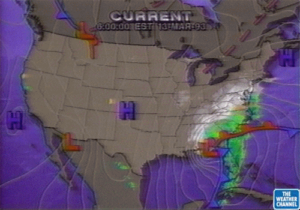
Only in 1982 did we see the first significant application of augmented reality with Dan Reitan’s invention of RADAR for weather broadcasting.[3] This is not the same as augmented reality as we know it today because there is no footage from a digital camera, however, it is still considered one of the first applications of augmented reality. Skipping forward, we see another application of augmented reality on the television in NFL football. In 1998 a company called Sportvision (now SMT) introduced the concept of the a yellow first down line projected on the screen of viewer.[4]
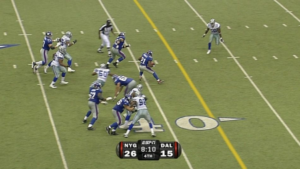
It wasn’t until the 1990’s that augmented reality started becoming a more popular technology. In 1990 Tom Caudell coined the term “augmented reality” to describe a heads up display system he developed for Boeing. In 1995 he wrote an article describing the differences between augmented reality and virtual reality as he knew it, and highlighted how the main difference was that augmented reality applications could be achieved with far less computing power than virtual reality applications.[5]
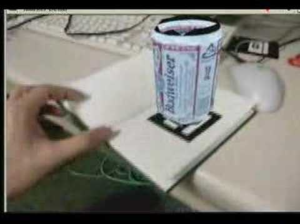
In 1996, Jun Rekimoto of Sony’s Computer Science Laboratory dramatically changed the way we use augmented reality today, and I think it was the most important milestone in the history of the technology. Rekimoto introduced the concept of marker based augmented reality by using inexpensive sensors like a web camera. Using his software “CyberCode”, he found that it was possible to identify two-dimensional barcode like markers and detect their three-dimensional positions and directions to project an image as if it exists in the real world. This was a huge step for augmented reality development because it showed developers can use the tools they already have to make augmented reality applications, and introduced the concept of marker-based augmented reality which is still very relevant.[6]
In 2000 Hirokazu Kato released ARToolKit which was the first open source library for making augmented reality applications. ARToolKit allowed developers to project images using physical markers like a barcode or natural feature markers like a table. ARToolKit became heavily used in mobile phones to develop augmented reality apps, and was the best option for developers for years.[7] It was not until 2009 that augmented reality on a web browser became possible with FLARToolKit. This open-source library uses flash-based technologies to make augmented reality possible through a browser. Therefore, the history of augmented reality on a web-browser is far shorter than augmented reality on mobile platforms.
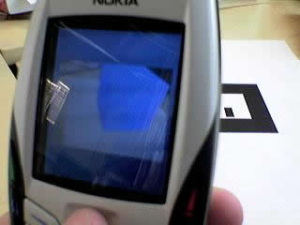
Getting Started
Since 2010 there have been many libraries that have been released for developing augmented reality apps. Now that we understand the history augmented reality grew in the past, we can begin to explore the best ways to develop augmented reality apps today. Augmented reality for mobile platforms has more established libraries. Building apps for an iPhone with iOS 11 is possible by using both like ARKit and ARCore. Using ARKit is possible by using Xcode and Swift to develop iPhone apps. Here is a link to a page on GitHub with many open-source projects using ARKit. Amazon uses ARKit to show products on their shopping app. Development for Android and Apple devices is possible using ARCore. Here is a link to an page with many open-source projects with cool projects using ARCore.
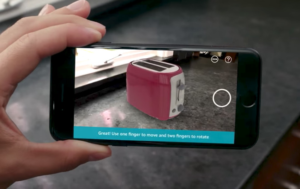
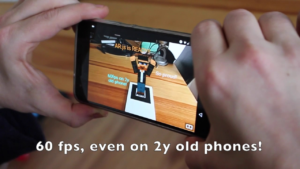
Libraries for developing augmented reality applications for a web browser are not yet as developed as one’s for a mobile device yet. Currently the fastest and most robust applications on a web-browser are marker based. As we learnt earlier, this was the technology that developed in 1996. Using AR.js and WebAR together it is very easy to make a marker based application viewable on a mobile or desktop browser. Here is a link to an article that shows you how you can create such an app. Libraries for developing augmented reality web applications based on natural features are very new and growing fast.
Works Cited
- http://www.historyofinformation.com/expanded.php?id=4698
- http://www.mortonheilig.com/SensoramaPatent.pdf
- https://isl.co/2018/01/every-major-ar-development-platform-and-why-its-important/
- https://www.smt.com/
- https://www.spiedigitallibrary.org/conference-proceedings-of-spie/2351/0000/Introduction-to-augmented-and-virtual-reality/10.1117/12.197320.full?SSO=1
- https://www.sonycsl.co.jp/tokyo/320/
- https://web.archive.org/web/20160303222853/http://webstaff.itn.liu.se/~andhe/UMAR
